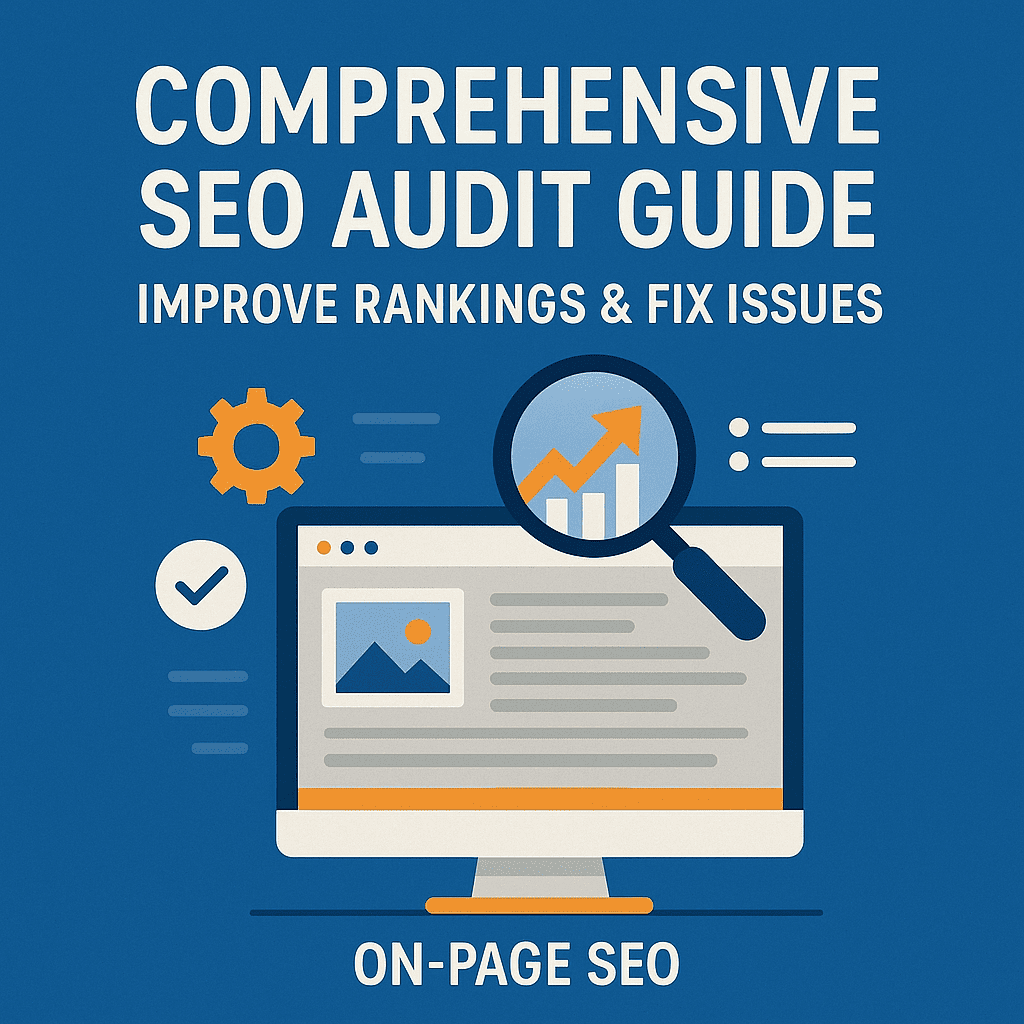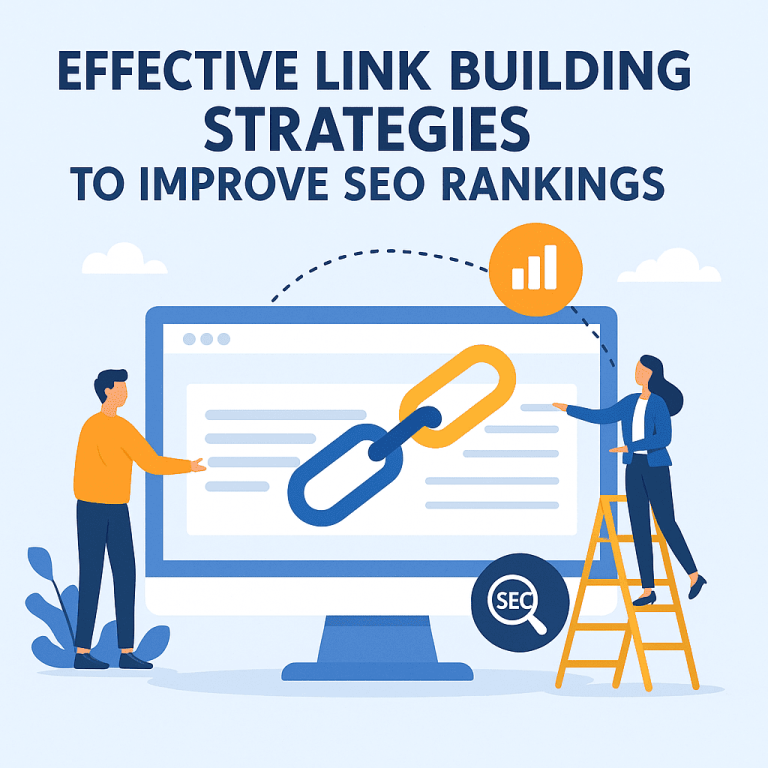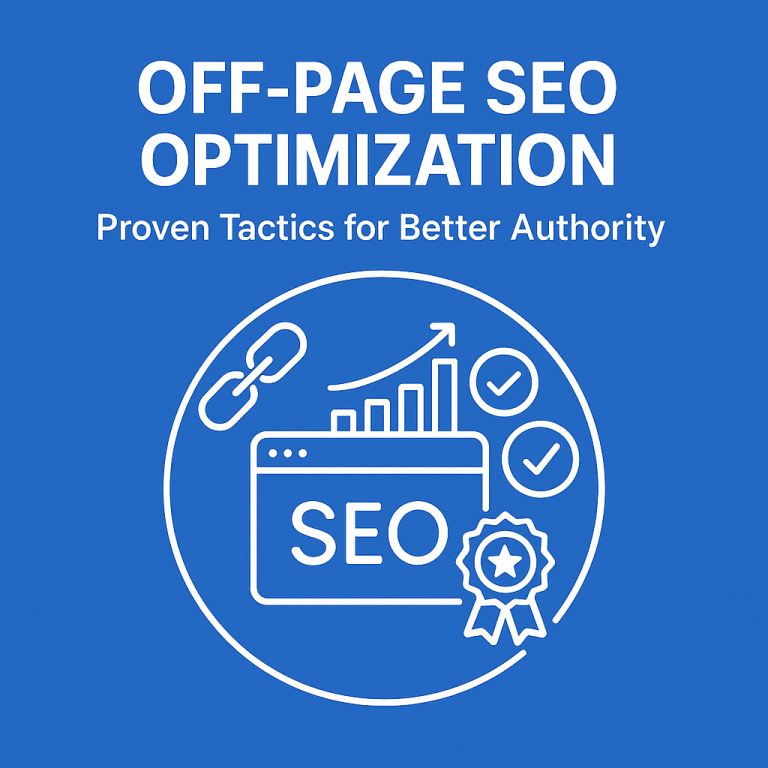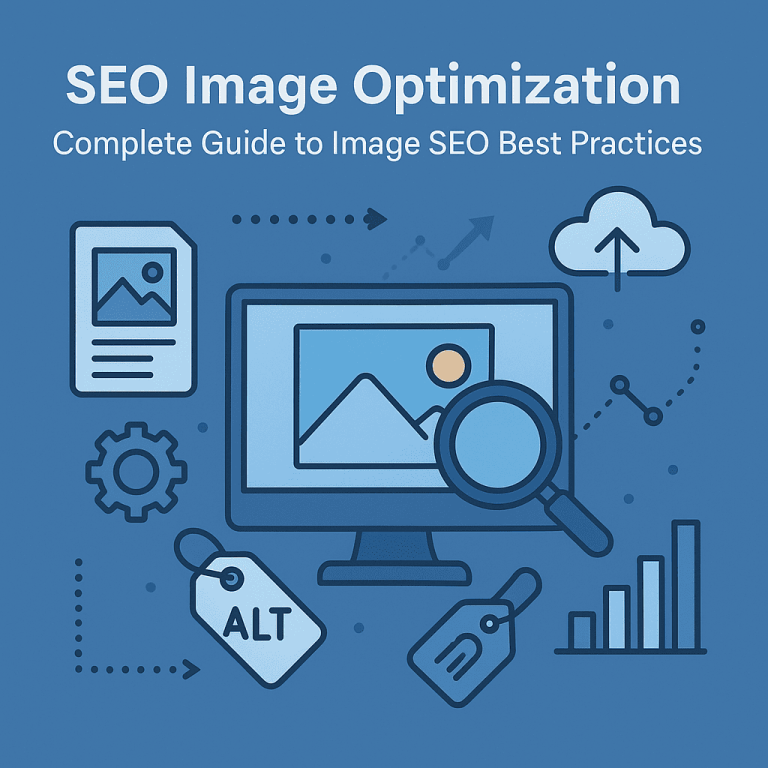Comprehensive SEO Audit Guide: Improve Rankings & Fix Issues On-Page SEO
Introduction to SEO Audits
An SEO audit is an in-depth examination of a website’s performance in search engines. It helps identify the factors that may prevent a site from ranking effectively. Through an audit, we assess how well your website follows SEO best practices and where improvements can make the most difference.
We focus on technical, on-page, and content-related aspects to ensure that every part of your site contributes to better search performance. An SEO audit is not a one-time task—it’s an ongoing effort to maintain a strong and sustainable ranking position in search results.
Importance of Conducting a Full SEO Audit
Performing a full SEO audit allows us to evaluate a website’s overall health. Search engines evolve constantly, and what worked six months ago may not deliver results today. By conducting regular audits, we can detect outdated elements, technical errors, or broken links that limit performance.
An SEO audit also uncovers missed opportunities, such as unoptimized pages, duplicate content, or underused keywords. It provides a roadmap for making strategic improvements that align your site with the latest search engine standards, resulting in more stable and higher search rankings over time.
Key Elements of an On-Page SEO Audit
An on-page SEO audit focuses on the factors directly controlled within your website. It involves analyzing content, meta data, HTML structure, and usability to ensure each page is optimized effectively.
We review critical elements such as title tags, header hierarchy, internal links, and content depth. An effective on-page audit also examines URL structure, schema markup, and user engagement signals like bounce rate and time on page. By fine-tuning these internal elements, we improve the search engine’s understanding of your content and enhance user experience simultaneously.
How to Analyze Website Structure and Internal Linking
A logical website structure helps both users and search engines navigate your content efficiently. During an audit, we evaluate your site’s hierarchy—how pages are organized from the homepage down to the deepest subpages.
A clear, well-organized structure allows search crawlers to find and index pages easily. Internal linking plays a vital role here; links between related pages distribute authority across the site and guide visitors toward relevant content.
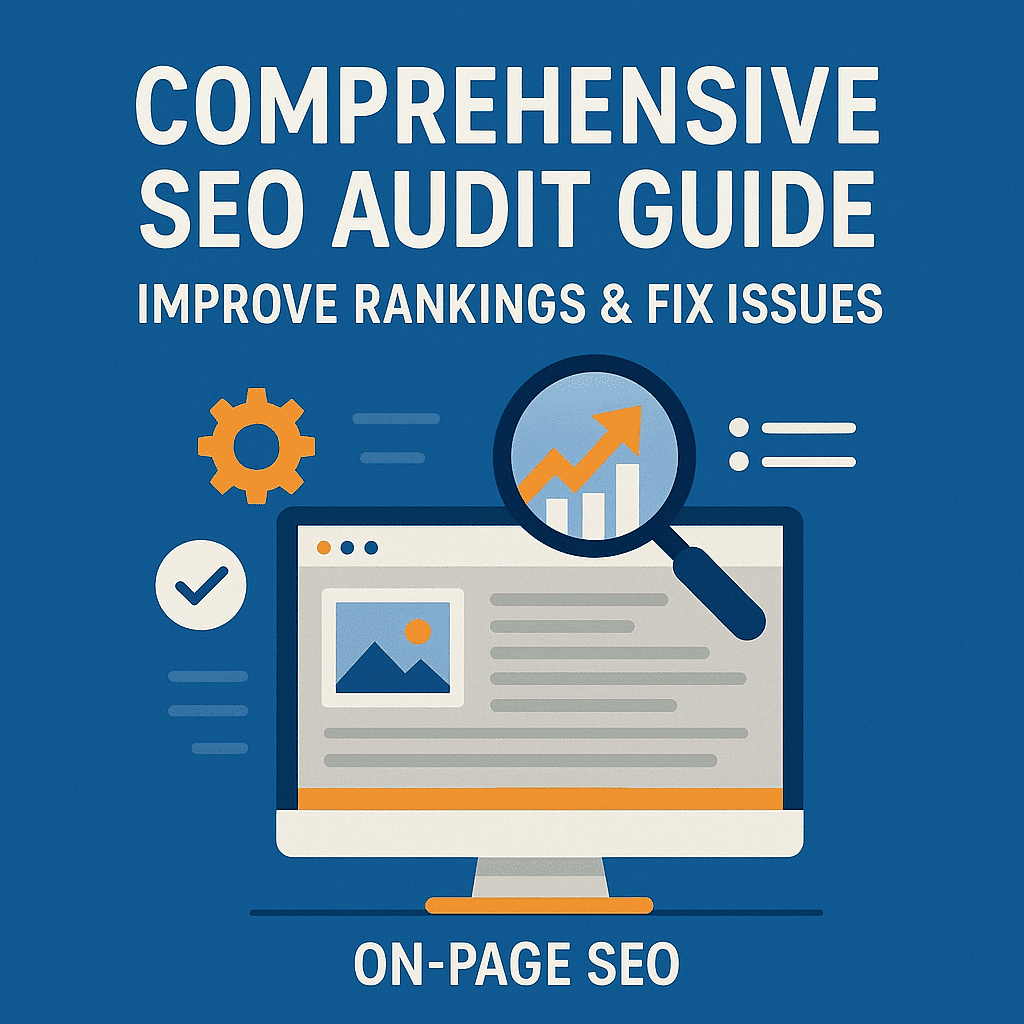
We examine anchor text usage, link depth, and orphaned pages. Links should use descriptive text that reflects the target page’s content. Avoid overlinking or creating loops that confuse crawlers. Effective internal linking not only strengthens topical relevance but also helps users discover valuable information faster.
Checking Meta Tags and Header Tags
Meta tags and headers are small yet powerful SEO components. During an audit, we assess whether every page includes a unique title tag and meta description that accurately reflect the page’s content. Title tags should be concise and keyword-focused, while meta descriptions should encourage clicks through informative summaries.
Header tags (H1, H2, H3) organize the content logically and improve readability. Each page should have one clear H1 tag that includes the main keyword, followed by subheadings that segment topics. We check for missing headers, duplicate titles, or tag misuse, ensuring the structure aligns with search engine best practices.
Evaluating Content Quality and Keyword Usage
High-quality content lies at the heart of successful SEO. During an audit, we analyze content for depth, originality, and relevance to search intent. Content should answer user questions, provide actionable insights, and maintain an appropriate keyword balance.
We identify keyword stuffing, missing keyword opportunities, or outdated text that no longer matches user intent. Each page should target specific keyword themes while remaining natural and informative. We also look at semantic variations—related terms that support the main topic. Strong content encourages engagement and reduces bounce rates, which are both positive signals for search engines.
Identifying Technical Issues Affecting On-Page SEO
Even the best-written content can underperform if technical barriers exist. A key part of an SEO audit involves detecting technical issues that impact on-page performance. We examine factors such as page load speed, mobile responsiveness, crawlability, and indexation status.
Slow loading times discourage visitors and reduce ranking potential. We also check for broken links, redirect chains, duplicate content, and canonical errors. Structured data validation ensures that search engines can interpret your content correctly. Addressing these issues improves both user experience and search engine accessibility.
Tools for Conducting On-Page SEO Audits
Performing a comprehensive SEO audit requires reliable tools. We combine several trusted platforms to collect accurate data and insights.
1. Google Search Console
It reveals indexing status, search performance, and technical warnings. We use it to identify coverage issues, keyword performance, and mobile usability problems.
2. Google Analytics
Analytics helps us understand user behavior, including bounce rate, session duration, and conversion patterns. This data highlights which pages need improvement.
3. Screaming Frog SEO Spider
This tool crawls the website just like a search engine does. It identifies missing meta tags, broken links, and duplicate titles efficiently.
4. Ahrefs and SEMrush
These tools provide comprehensive insights into keyword performance, backlinks, and content quality. We use them to spot ranking drops and audit page-level optimization.
5. PageSpeed Insights
Google’s PageSpeed tool evaluates site performance metrics and provides recommendations for faster loading and better Core Web Vitals.
6. GTmetrix
GTmetrix measures page speed, load time, and optimization score. It helps pinpoint performance bottlenecks that affect SEO.
7. Sitebulb
An advanced auditing tool that provides visual site maps and detailed reports on crawl errors, link distribution, and structured data.
Combining data from multiple tools ensures a precise and complete overview of your site’s strengths and weaknesses.
Common SEO Audit Mistakes to Avoid
Many businesses make errors when auditing their websites. Recognizing these mistakes helps us perform audits more effectively.
Ignoring Mobile Performance
A large portion of traffic comes from mobile devices. Ignoring mobile usability can cause ranking drops, as search engines prioritize mobile-first indexing.
Overlooking Duplicate Content
Duplicate pages dilute keyword authority and confuse search engines. We use canonical tags and consolidation strategies to resolve such issues.
Neglecting Internal Links
Missing or broken internal links waste link equity and disrupt user navigation. Each page should contribute to a well-connected structure.
Using Inaccurate Data
Relying on old or incomplete analytics can misguide decisions. We ensure all data sources are synchronized and current.
Skipping Page Speed Testing
Even minor speed delays can affect engagement and conversion. Regular speed audits are essential to keep performance consistent.
Not Reviewing Meta Information
Meta tags that are missing, duplicated, or poorly written hurt both ranking and click-through rates. Every page should have unique, optimized tags.
By avoiding these common pitfalls, we ensure our audits deliver actionable results that improve overall website health and ranking performance.
Final Audit Checklist Summary
To make the audit process more practical, we summarize the essential points into a structured checklist. This ensures no important element is overlooked during the review.
1. Website Structure
- Ensure logical hierarchy of pages.
- Review internal linking and remove orphaned pages.
- Confirm descriptive, keyword-focused URLs.
2. Meta Data and Headers
- Unique title tags and meta descriptions for every page.
- Proper header tag structure (H1, H2, H3).
- Avoid keyword repetition or duplication.
3. Content Quality
- Ensure text is original and user-focused.
- Include relevant keywords and synonyms naturally.
- Eliminate thin or outdated content.
4. Technical Checks
- Test site speed and Core Web Vitals.
- Ensure mobile responsiveness.
- Identify and fix broken links and redirects.
- Verify structured data markup.
5. Image Optimization
- Use descriptive filenames and alt text.
- Compress images for faster load times.
- Implement responsive image formats.
6. Crawlability and Indexation
- Check robots.txt and sitemap.xml.
- Review index coverage reports in Search Console.
- Eliminate crawl errors or blocked pages.
7. User Engagement Metrics
- Analyze bounce rate, dwell time, and page interactions.
- Improve navigation and readability for better engagement.
This checklist acts as a clear roadmap, helping us maintain consistency and efficiency during every SEO audit.
How On-Page SEO Audits Differ from Technical Audits
While both aim to improve rankings, on-page audits emphasize what users and search engines can see directly on your pages—titles, content, images, and internal links. Technical audits, on the other hand, focus on server performance, crawl errors, and indexing behavior.
During our on-page audits, we prioritize user experience and content relevance. We also ensure all elements are optimized to communicate clearly with search engines, making it easier for them to interpret your site’s context and value.
The Role of Keyword Mapping During an Audit
Keyword mapping helps us align each page with its most appropriate search intent. We review the existing keywords on every page and compare them to target queries that potential customers use.
By identifying overlaps, gaps, and irrelevant terms, we make informed decisions about which keywords deserve emphasis. Proper keyword mapping ensures there’s no internal competition between your pages—commonly known as keyword cannibalization—and that every piece of content serves a clear purpose.
Reviewing URL Structure for SEO Clarity
URLs should be descriptive, concise, and consistent. A clean structure improves crawl efficiency and user comprehension. During an audit, we identify any parameters, redundant subfolders, or dynamic strings that complicate URLs.
We aim for short URLs that include target keywords where appropriate. A well-structured URL also contributes to higher click-through rates, as users can easily understand what the page is about from the link alone.
Importance of Schema Markup in On-Page SEO
Schema markup helps search engines interpret the meaning behind your content. We analyze your site to ensure that structured data is implemented correctly for articles, products, services, and local businesses.
Proper schema markup increases the chances of rich snippets—enhanced search results that display ratings, FAQs, or event information. These details make listings more attractive and informative, helping your site earn more clicks organically.
Improving Readability and User Experience
Search engines favor content that engages readers. We assess readability by examining paragraph length, transition words, and overall structure. Text should be scannable with subheadings, bullet points, and concise sentences.
We also analyze font size, color contrast, and mobile spacing to ensure comfort across all devices. Enhancing user experience supports higher engagement metrics, which positively influence ranking potential.
Using Analytics to Prioritize Audit Findings
Not every issue found in an audit carries the same impact. We use analytics to determine which fixes will deliver the highest return. For example, a slow-loading page with strong traffic demands immediate attention, while a low-traffic blog post with minor meta issues might rank lower on the priority list.
This data-driven prioritization ensures efficient use of time and resources, focusing efforts where improvements will lead to measurable ranking gains.
Auditing Internal Anchor Text Relevance
Anchor text connects pages and provides context about the linked content. We analyze anchor distribution to avoid overuse of exact-match keywords. Links should look natural and flow within the text.
An audit also examines balance—some pages may have too many internal links, while others remain underlinked. Rebalancing ensures that link equity flows evenly throughout your website, reinforcing both authority and usability.
Analyzing Content Gaps and Keyword Expansion
We look beyond existing pages to identify missing content opportunities. Content gap analysis compares your site with top-ranking competitors, revealing topics or questions your audience seeks but your site hasn’t covered yet.
Filling those gaps through new or expanded pages enhances topical authority and increases the likelihood of capturing additional search queries, improving the overall footprint of your website in search results.
Image Optimization Audit
Images are valuable for both aesthetics and SEO. We review image size, format, and compression level to ensure they load quickly without sacrificing quality. Each image must have an appropriate filename and alt attribute describing its content.
Additionally, we check if images are served in next-gen formats like WebP and if they are responsive across screen sizes. Proper image optimization enhances page speed, accessibility, and ranking potential.
Mobile SEO Audit Considerations
Mobile-first indexing means Google primarily uses the mobile version of your site for ranking. We examine how your website renders on different screen sizes, focusing on layout, tap targets, and font readability.
Any overlapping elements, unresponsive menus, or hidden text can hurt performance. We also test mobile speed using tools like Lighthouse to ensure users get a seamless browsing experience.
Core Web Vitals and Performance Metrics
Core Web Vitals measure user experience through loading, interactivity, and visual stability. We assess three metrics: Largest Contentful Paint (LCP), First Input Delay (FID), and Cumulative Layout Shift (CLS).
A strong performance in these metrics signals to search engines that your site delivers a smooth user experience. We provide detailed recommendations—such as image compression, caching, or code minification—to improve these vital scores.
Evaluating Backlinks During an On-Page Audit
Although backlinks fall under off-page SEO, understanding how inbound links interact with on-page structure is important. We verify that all linked pages still exist and are properly redirected if moved.
Pages with strong backlinks deserve extra care—they should contain optimized titles, fresh content, and proper indexing. Losing optimization on such pages can waste valuable link authority.
Improving Meta Descriptions for CTR
A compelling meta description can significantly influence click-through rate. We rewrite meta descriptions to include the target keyword and a clear call-to-action. The goal is to make users click through naturally without using clickbait.
Each meta description must be under 160 characters, concise, and informative. During the audit, we flag duplicates and ensure every page includes a unique summary aligned with user intent.
Handling Canonical Tags and Duplicate Content
Canonical tags guide search engines on which version of a page should be indexed. We ensure canonicalization is implemented properly to avoid dilution of ranking signals.
Duplicate content often arises from printer-friendly versions, product filters, or session IDs. Detecting and consolidating such duplicates keeps indexing efficient and reinforces authority on the main page.
Why Regular Audits are Necessary
Search engines evolve rapidly, and even small updates can impact performance. Regular audits maintain your website’s alignment with the latest ranking factors.
We recommend conducting a full audit quarterly or after significant updates. Consistent evaluation prevents small issues from escalating into larger performance losses.
Practical Example of an SEO Audit Workflow
- Initial Crawl: Gather site data using Screaming Frog or Sitebulb.
- Technical Review: Check indexing, redirects, and canonical settings.
- On-Page Evaluation: Examine titles, headers, and keyword placement.
- Content Review: Assess quality, depth, and engagement metrics.
- Performance Testing: Measure load speed and mobile usability.
- Prioritization: Rank issues by severity and potential impact.
- Implementation: Apply fixes systematically, monitoring improvements in performance metrics.
Tracking Audit Results Over Time
After implementing changes, tracking progress is vital. We monitor organic traffic growth, keyword rankings, and engagement metrics. Comparing pre- and post-audit performance shows the effectiveness of each fix.
We document improvements and adjust strategies based on data trends. Continuous monitoring keeps your SEO efforts aligned with evolving market conditions.
Benefits of Partnering with SEO Supremacy for SEO Audits
When you choose SEO Supremacy, you gain more than an audit—you gain a team committed to measurable progress. We combine technical expertise with practical insights to create reports that are both understandable and actionable.
Our experts don’t just identify issues; we explain why they matter and how resolving them impacts your ranking potential. The outcome is a structured, data-driven foundation for consistent SEO success.
Conclusion
A comprehensive SEO audit forms the foundation of long-term search success. It reveals what’s holding your website back and highlights new opportunities for growth.
Through careful evaluation of on-page elements, technical factors, and user experience, we transform data into clear, actionable recommendations. Each improvement—no matter how small—contributes to stronger rankings, faster performance, and greater user satisfaction.
